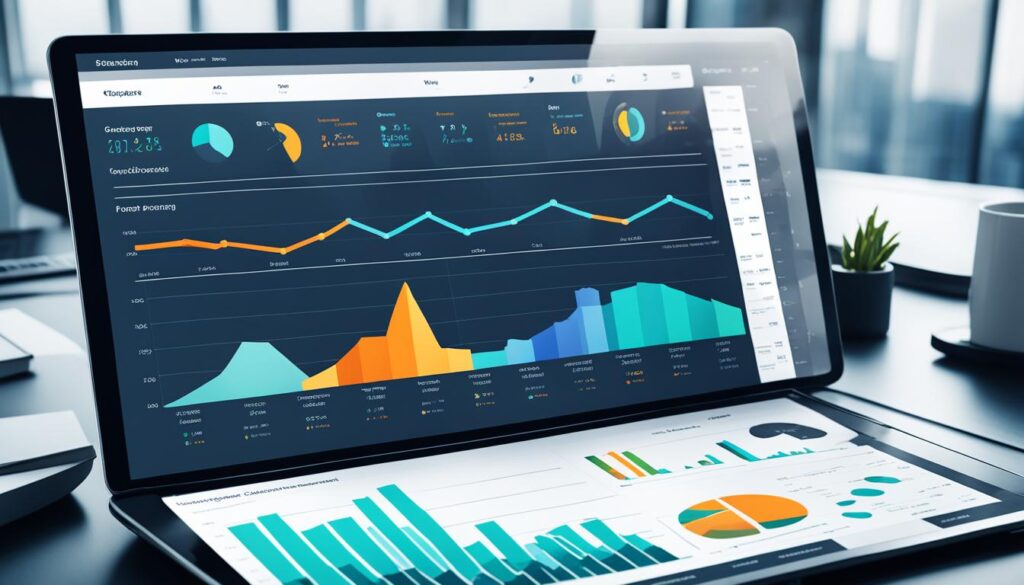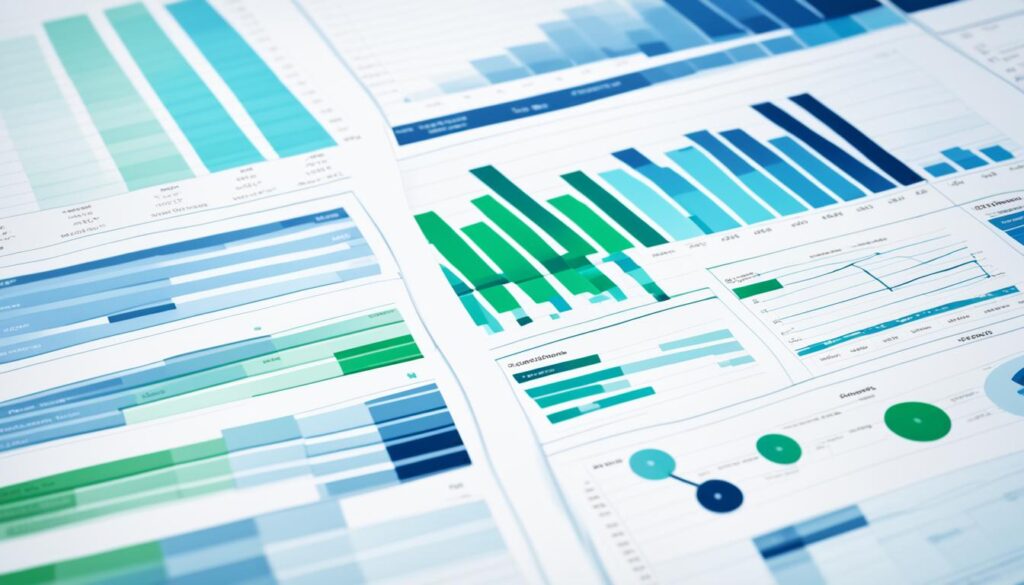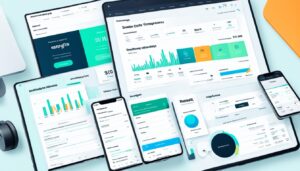Financial reporting and analysis are vital components of a successful business strategy. By effectively tracking and interpreting financial data, organizations can gain valuable insights into their financial health, make informed decisions, and drive growth. In this article, we will explore the importance of financial reporting, the types of financial reports, the benefits it offers, and the future trends shaping this field.
Key Takeaways:
- Financial reporting and analytics provide valuable insights into a company’s financial performance and stability.
- Financial reporting tools and software are essential for accurate data analysis and interpretation.
- Financial reporting helps businesses make informed decisions, ensure compliance, and drive growth.
- Financial analysis allows companies to identify trends, assess risks, and evaluate investment opportunities.
- The future of financial reporting is driven by advancements in technology, such as AI and machine learning.
The Importance of Financial Reporting
Financial reporting is a critical aspect of running a successful business. It provides valuable insights into a company’s financial performance, stability, and overall health. By tracking key financial metrics such as revenue, expenses, profits, and cash flow, businesses can make informed decisions regarding resource allocation, investment opportunities, and growth strategies.
Effective financial management and planning rely heavily on financial reporting tools and analysis. These tools enable businesses to organize and interpret financial data, uncover trends, and identify areas for improvement. With a comprehensive understanding of their financial position, companies can confidently navigate the complexities of today’s business landscape.
“Financial reporting helps businesses understand their current financial standing and make strategic decisions based on accurate and reliable data.”
Having access to real-time financial information is crucial for informed decision-making. Financial reporting tools allow businesses to generate relevant reports on-demand, providing up-to-date insights into the company’s performance. This empowers stakeholders to take timely actions and adapt their strategies accordingly.
Furthermore, financial reporting aids in regulatory compliance. Businesses must adhere to various financial regulations, and accurate financial reporting ensures transparency and authenticity in their financial statements. This not only helps build trust with stakeholders but also mitigates legal risks and potential penalties.
In summary, financial reporting is an indispensable component of effective financial management. By utilizing financial reporting tools and analysis, businesses can understand their financial position, make informed decisions, and establish a solid foundation for future growth and success.
Benefits of Financial Reporting:
- Track revenue, expenses, and cash flow
- Make informed decisions about resource allocation
- Identify investment opportunities
- Evaluate growth strategies
- Ensure regulatory compliance
Testimonial:
“Financial reporting tools have revolutionized how we manage our company’s finances. With real-time insights and accurate data, we can confidently make strategic decisions to drive growth and success.”
– Rachel Smith, CFO
Types of Financial Reports
Financial reports are essential tools that businesses utilize to communicate their financial information effectively. These reports provide valuable insights into various aspects of a company’s financial health and performance, enabling informed decision-making. Let’s explore some of the key types of financial reports:
1. Income Statements
An income statement, also known as a profit and loss statement, provides a summary of a company’s revenues, expenses, and net income over a specific period. It helps assess the financial performance and profitability of a business, highlighting the sources of revenue and the costs associated with generating those revenues.
2. Balance Sheets
A balance sheet offers a snapshot of a company’s financial position at a given point in time. It presents the company’s assets, liabilities, and shareholders’ equity, providing insights into its financial stability and solvency. The balance sheet follows the fundamental accounting equation, where assets equal liabilities plus shareholders’ equity.
3. Cash Flow Statements
A cash flow statement tracks the movement of cash within a business during a specific period. It consists of three sections: operating activities, investing activities, and financing activities. This report helps evaluate a company’s ability to generate and manage cash, providing crucial information about cash inflows and outflows.
4. Statements of Shareholder Equity
Statements of shareholder equity outline the changes in the company’s equity capital over a period. It reflects the transactions related to stock issuances, repurchases, dividends, and changes in retained earnings. This report helps stakeholders understand how the company’s ownership and equity have evolved.
5. Statements of Retained Earnings
Statements of retained earnings show the changes in a company’s retained earnings over a period. It includes adjustments for net income, dividends paid to shareholders, and any prior-period adjustments. This report helps track the distribution of profits and assess the company’s reinvestment strategies.
6. Environmental, Social, and Governance (ESG) Reports
ESG reports provide information about a company’s environmental, social, and governance practices. These reports focus on sustainable and responsible business practices, addressing areas such as carbon emissions, diversity and inclusion, labor practices, and ethical governance. ESG reporting enables stakeholders to evaluate a company’s non-financial performance.
Data analytics plays a vital role in generating accurate and meaningful financial reports. By leveraging advanced analytical tools, businesses can derive valuable insights from financial data, facilitating informed decision-making and enhancing performance reporting.
| Financial Report | Purpose | Key Insights |
|---|---|---|
| Income Statements | Evaluating profitability and revenue sources | Revenue, expenses, net income |
| Balance Sheets | Assessing financial position and stability | Assets, liabilities, shareholders’ equity |
| Cash Flow Statements | Tracking cash movement and liquidity | Cash inflows, cash outflows |
| Statements of Shareholder Equity | Understanding changes in equity capital | Stock issuances, repurchases, dividends |
| Statements of Retained Earnings | Tracking the distribution of profits | Net income, dividends, prior-period adjustments |
| ESG Reports | Evaluating non-financial performance | Environmental, social, governance practices |
Benefits of Financial Reporting
Financial reporting plays a crucial role in the success of businesses. It offers several key benefits that contribute to effective financial planning and analysis, ensuring the financial health and growth of organizations. Let’s explore some of the significant advantages of financial reporting:
1. Debt Management
Financial reporting provides valuable insights into a company’s financial obligations, enabling businesses to manage their debts efficiently. By analyzing financial reports, organizations can assess their debt-to-equity ratio, debt coverage ratio, and other debt-related metrics to make informed decisions regarding loan repayments and debt restructuring.
2. Trend Identification
Through financial reporting, businesses can identify and analyze trends in their financial performance over time. By comparing financial statements from different periods, organizations gain a deeper understanding of revenue growth, cost fluctuations, and profitability trends. This helps organizations identify patterns and take corrective actions or leverage opportunities accordingly.
3. Cash Flow Tracking
Financial reports enable businesses to track their cash flow effectively. By monitoring cash inflows and outflows, organizations can identify cash surplus or shortage situations. This insight allows organizations to make timely adjustments to their cash flow management strategies, ensuring sufficient funds for operational needs, investments, and debt obligations.
4. Compliance with Financial Regulations
Financial reporting ensures businesses comply with financial regulations and reporting standards imposed by regulatory bodies. By following these guidelines, organizations maintain transparency and accountability, promoting trust among stakeholders such as investors, creditors, and government entities.
5. Effective Communication and Data Access
Financial reports serve as a means of effective communication, allowing businesses to disseminate financial information to internal and external stakeholders. By providing clear and concise data, financial reporting facilitates informed decision-making, enabling stakeholders to understand the organization’s financial performance, potential risks, and growth opportunities. Additionally, financial reporting enhances data access, allowing stakeholders to retrieve relevant financial information for analysis and decision-making.
Overall, financial reporting ensures businesses have a clear understanding of their financial position, performance, and potential areas of improvement. This empowers organizations to make strategic decisions, optimize resources, and achieve long-term financial stability and growth.
With reliable financial reports as a foundation, efficient financial planning and analysis are possible. Organizations can leverage advanced financial reporting software to streamline the reporting process, enhance data accuracy, and generate comprehensive insights for informed decision-making.
Use Cases for Financial Reporting
Financial reporting serves a variety of important use cases for businesses. By leveraging financial analysis, reporting software, and reporting systems, companies can gain valuable insights that drive decision-making and improve overall performance.
Evaluating Profitability
One key use case for financial reporting is assessing profitability. By analyzing financial data, companies can determine the profitability of products, services, or business segments. This information allows businesses to allocate resources effectively and make strategic decisions that maximize profitability.
Assessing Financial Risks
Financial reporting also helps businesses evaluate and manage financial risks. By monitoring key financial indicators, such as debt levels, liquidity ratios, and leverage ratios, companies can identify potential risks and take proactive measures to mitigate them. This enables businesses to minimize financial vulnerabilities and improve overall stability.
| Use Case | Benefits |
|---|---|
| Evaluate Investment Opportunities | Make informed investment decisions based on comprehensive financial analysis. |
| Measure Performance Against Targets | Track financial performance and determine if targets are being met or exceeded. |
| Comply with Regulatory Requirements | Ensure adherence to financial reporting regulations and requirements. |
Evaluating Investment Opportunities
Financial reporting plays a crucial role in evaluating investment opportunities. By analyzing financial data, companies can assess the potential returns and risks associated with different investment options. This enables businesses to make informed investment decisions that align with their strategic objectives and risk appetite.
Measuring Performance Against Targets
Financial reporting allows businesses to measure their performance against predefined targets. By comparing actual financial results to budgeted or forecasted figures, companies can identify areas of strength and areas that require improvement. This helps management make data-driven decisions and take corrective actions to achieve their financial goals.
Complying with Regulatory Requirements
Another important use case for financial reporting is to ensure compliance with regulatory requirements. Businesses are obligated to report accurate and timely financial information to regulatory bodies. By using financial analysis and reporting systems, companies can generate regulatory-compliant reports that meet the necessary legal and industry-specific guidelines.
Financial reporting streamlines these use cases and provides businesses with actionable insights that inform their decision-making processes. By leveraging financial reporting software, businesses can automate data collection, analysis, and reporting, leading to increased efficiency and accuracy in financial reporting.
Users of Financial Reporting and Analysis
Financial reporting and analysis serve as crucial tools for various stakeholders involved in assessing and managing a company’s finances. Let’s take a closer look at the key users of financial reporting and analysis:
1. Shareholders and Investors
Shareholders and investors heavily rely on accurate and transparent financial reports to gain insights into a company’s financial health. These reports help them evaluate profitability, assess risks, and make informed decisions about investing in the company. By analyzing financial statements, performance metrics, and key ratios, shareholders and investors can determine the value and potential return on their investment.
2. Lenders and Creditors
Lenders and creditors use financial reports to assess a company’s creditworthiness before extending loans or credit facilities. By examining financial statements, cash flow projections, and debt-to-equity ratios, lenders can evaluate the company’s ability to meet its financial obligations. This information helps them make informed decisions on loan approvals and determine interest rates based on the level of risk presented by the company.
3. Financial Managers
Financial managers rely on financial reports and analysis to effectively monitor and manage a company’s finances. These reports provide valuable insights into revenue generation, cost management, cash flow, and profitability. By analyzing financial data, financial managers can identify areas for improvement, make informed budget decisions, and develop strategies for maximizing financial performance.
4. Regulatory Bodies
Regulatory bodies, such as government agencies and industry-specific authorities, rely on financial reports to ensure compliance with financial regulations and standards. These reports help regulatory bodies monitor financial activities, detect fraud or misconduct, and maintain transparency within the market. By reviewing financial reports, regulatory bodies can enforce compliance, protect stakeholders’ interests, and maintain the integrity of the financial system.
By catering to the needs of these diverse stakeholders, financial reporting and analysis plays a vital role in fostering transparency, informing decision-making, and ensuring accountability within organizations.
Different Approaches to Financial Reporting
When it comes to financial reporting, businesses have the flexibility to choose from various approaches based on their unique needs and industry requirements. While some companies still rely on manual reporting methods, others are embracing the benefits of financial reporting systems and software to automate the process. Let’s explore these different approaches and the advantages they offer.
Manual Reporting: In manual reporting, companies rely on traditional methods of collecting, organizing, and analyzing financial data. This approach involves manually inputting data into spreadsheets or templates, making it prone to errors and time-consuming. Manual reporting also limits the scope of financial analytics, as it can be challenging to perform complex data analysis and generate comprehensive reports.
Financial Reporting Systems: Leveraging financial reporting systems brings numerous benefits to businesses. These systems allow for streamlined data collection, aggregation, analysis, and report generation. With the help of intuitive interfaces and automated processes, financial reporting systems significantly reduce the risk of errors and improve the accuracy and efficiency of reporting. These systems also offer robust security measures to protect sensitive financial information.
Reporting Software: Reporting software complements financial reporting systems by providing advanced analytical capabilities. This software enables businesses to perform in-depth financial analytics, visualize data in meaningful ways, and generate actionable insights. By utilizing reporting software, companies can make data-driven decisions, identify trends, and forecast future financial performance.
The Advantages of Financial Analytics
“Financial analytics empowers businesses to gain valuable insights from their financial data, enabling them to make informed decisions and drive growth.”
Financial analytics is a critical component of modern financial reporting, enabling businesses to extract meaningful insights from their financial data. By utilizing financial analytics tools, companies can:
- Identify patterns and trends in financial data
- Evaluate the financial impact of business decisions
- Improve forecasting accuracy
- Identify opportunities for cost reduction and revenue growth
- Monitor key performance indicators (KPIs)
The combination of financial reporting systems and reporting software offers businesses a powerful foundation for accurate financial reporting, efficient data analysis, and informed decision-making. With these tools at their disposal, companies can unlock valuable insights and gain a competitive edge in the dynamic business landscape.
| Approach | Advantages |
|---|---|
| Manual Reporting |
|
| Financial Reporting Systems |
|
| Reporting Software |
|
Key Elements of Financial Reporting Systems
Effective financial reporting systems rely on several key elements to ensure the accuracy and reliability of financial reports. These elements encompass critical processes that enable organizations to collect, analyze, interpret, generate reports, and visualize data. By leveraging reporting software and tools, businesses can gain comprehensive insights for effective financial analysis and decision-making.
Data Collection and Aggregation
The first key element of financial reporting systems is data collection and aggregation. This involves gathering financial data from various sources within the organization, such as accounting software, databases, and spreadsheets. The collected data is then aggregated and organized in a structured manner to facilitate analysis and reporting.
Data Analysis and Interpretation
Once the data is collected and aggregated, the next step is data analysis and interpretation. This process involves applying financial analysis techniques to gain insights into the organization’s financial performance and trends. Financial analysis methods include ratio analysis, trend analysis, and benchmarking, among others. The results of the analysis help stakeholders understand the financial health of the organization and make informed decisions.
Report Generation
After analyzing the financial data, financial reporting systems generate reports that communicate the findings to stakeholders. These reports are typically in the form of financial statements, management reports, or dashboards. The report generation process involves organizing and presenting the analyzed data in a clear and concise manner, ensuring it is understandable to both financial and non-financial stakeholders.
Data Visualization
Data visualization is an essential element of financial reporting systems as it helps stakeholders understand complex financial information quickly. By using visual elements such as charts, graphs, and tables, data visualization makes it easier to interpret and absorb financial data. Visual representations of financial information enhance communication and enable stakeholders to identify trends, anomalies, and areas for improvement.
| Key Elements | Description |
|---|---|
| Data Collection and Aggregation | Gathering and organizing financial data from various sources within the organization. |
| Data Analysis and Interpretation | Applying financial analysis techniques to gain insights into the organization’s financial performance. |
| Report Generation | Creating clear and concise reports that communicate the analyzed financial information. |
| Data Visualization | Presenting financial data in visual formats such as charts, graphs, and tables. |
By incorporating these key elements into their financial reporting systems and utilizing reporting software and tools, organizations can enhance their financial analysis capabilities and ensure more effective decision-making.

The Power of Financial Analysis
Financial analysis is a powerful tool that allows businesses to gain deep insights into their performance, profitability, and overall financial health. By examining key financial statements, ratios, trends, and other metrics, companies can uncover valuable opportunities for improvement and make informed, data-driven decisions.
One of the key enablers of comprehensive financial analysis is advanced reporting software and systems. These tools provide essential functionality and capabilities necessary to perform an in-depth analysis of financial data. With reporting software, businesses can easily generate financial reports, visualize data, and perform complex calculations.
Financial reporting systems play a crucial role in streamlining the analysis process, as they offer a centralized platform for collecting, organizing, and processing financial data. These systems ensure data accuracy and integrity, allowing analysts to trust the information they are working with.
Moreover, reporting software and systems facilitate the comparison of financial data over time, enabling businesses to track performance, identify trends, and assess financial stability. By examining financial ratios and key performance indicators, companies can evaluate aspects such as liquidity, profitability, and efficiency, gaining valuable insights into their financial position and competitiveness.
Financial analysis is not limited to the examination of past performance; it also plays a crucial role in forecasting and planning for the future. By analyzing historical data and market trends, businesses can make informed decisions about resource allocation, investment opportunities, and strategic initiatives.
By leveraging the capabilities of reporting software and systems, financial analysts can perform comprehensive and detailed analyses, uncovering hidden patterns and trends that may not be apparent at a surface level. These insights can inform critical business decisions, such as pricing strategies, cost optimization, and risk management.
| Benefits of Financial Analysis | Reporting Software and Systems |
|---|---|
| Identify areas for cost reduction | Automate data collection and analysis |
| Evaluate investment opportunities | Generate accurate and visual financial reports |
| Analyze profitability and revenue streams | Perform complex calculations and scenario modeling |
| Assess financial risks and mitigate them | Track performance metrics and KPIs |
The power of financial analysis lies in its ability to transform raw financial data into valuable insights that drive informed decision-making. With reporting software and systems, businesses can unlock the full potential of their financial data, gaining a competitive edge and positioning themselves for long-term success.
Overcoming Challenges in Financial Reporting
Financial reporting can present various challenges for businesses, requiring effective strategies and tools to address them. These challenges include managing large volumes of data, ensuring data accuracy, and meeting regulatory requirements. Fortunately, there are solutions available that can help businesses overcome these obstacles and streamline their financial reporting processes.
Automating Data Collection, Analysis, and Reporting
To manage the large volumes of data involved in financial reporting, businesses can leverage financial reporting tools and software. These tools automate data collection, analysis, and reporting, reducing the manual effort and potential for errors. By automating these processes, businesses can save time, improve efficiency, and ensure data accuracy.
Data Analytics for Detecting Inconsistencies and Errors
Data analytics plays a crucial role in financial reporting by helping businesses identify inconsistencies, errors, and outliers in their financial data. By utilizing data analytics techniques and tools, businesses can perform detailed analyses that go beyond simple data validation. These analyses enable them to detect patterns, trends, and potential issues that may impact the accuracy and reliability of financial reports.
Through data analytics, businesses can gain valuable insights into their financial data, identify areas for improvement, and take proactive steps to address any potential issues. This helps ensure the integrity and credibility of their financial reporting.
Meeting Regulatory Requirements
Compliance with regulatory requirements is a critical aspect of financial reporting. Businesses need to stay up to date with the latest regulations and ensure that their financial reports meet the necessary standards. Failure to comply with these regulations can result in penalties and reputational damage.
Financial reporting software can help businesses streamline their compliance efforts by providing built-in regulatory frameworks and automated reporting templates. These tools ensure that businesses adhere to the necessary regulations and produce accurate, compliant financial reports.
In summary, financial reporting presents challenges that can be overcome with the use of financial reporting tools, reporting software, and data analytics. By automating data collection, analysis, and reporting, businesses can effectively manage large volumes of data while ensuring accuracy and efficiency. Additionally, data analytics enables businesses to identify and address inconsistencies and errors in their financial data. Meeting regulatory requirements is also facilitated by the use of reporting software that incorporates regulatory frameworks and templates.
Future Trends in Financial Reporting
The future of financial reporting is set to be transformed by advancements in technology and the adoption of innovative reporting solutions. With the rise of artificial intelligence (AI) and machine learning, financial reporting systems are becoming more accurate, real-time, and efficient. These technological advancements offer numerous benefits to businesses, including enhanced data security, improved financial analysis capabilities, and streamlined reporting processes.
One significant trend in financial reporting is the integration of AI and machine learning algorithms. These technologies enable financial reporting software to automate data collection, analysis, and interpretation, leading to more accurate and reliable financial reports. By leveraging AI, financial reporting systems can process vast amounts of data and identify patterns and trends that humans may overlook. This enables businesses to make data-driven decisions and gain valuable insights into their financial performance.
Moreover, advanced predictive analytics capabilities are revolutionizing financial reporting. By analyzing historical financial data and external market trends, financial reporting software can provide businesses with valuable projections and forecasts. These predictive insights enable proactive decision-making and help businesses plan for the future effectively.
Data security is another critical focus in the future of financial reporting. As businesses continue to rely on digital systems and store sensitive financial information, ensuring the security and integrity of data is of utmost importance. Financial reporting systems are evolving to implement robust security measures, including encryption, access controls, and secure cloud storage.
“The integration of AI and machine learning in financial reporting is transforming the way businesses analyze and interpret their financial data. These technologies enable more accurate reporting, enhanced predictive analytics, and improved decision-making.”
In addition to technological advancements, the future of financial reporting will witness the evolution of reporting software and systems. Vendors are continuously innovating their offerings to meet the evolving needs of businesses, providing user-friendly interfaces, customizable reporting templates, and seamless integration with other financial management tools.
To illustrate the future trends in financial reporting, consider the following table:
| Future Trends in Financial Reporting | Description |
|---|---|
| The integration of AI and machine learning algorithms in financial reporting systems | |
| Advanced predictive analytics capabilities for accurate projections and forecasts | |
| Enhanced data security measures to protect sensitive financial information | |
| Ongoing innovation in reporting software and systems to meet businesses’ evolving needs |
“The future of financial reporting is promising, with technology playing a central role in transforming the accuracy, efficiency, and insights provided by reporting systems. Businesses can expect more advanced reporting capabilities, improved data security, and seamless integration with other financial management tools.”
Conclusion
Financial reporting and analytics are essential for businesses to make informed decisions, improve financial performance, and ensure compliance with regulatory requirements. With the help of advanced reporting software and systems, accurate data analysis, streamlined reporting processes, and enhanced financial management can be achieved.
By leveraging the power of financial reporting and analytics, businesses can gain valuable insights that drive growth and success in the ever-changing financial landscape. These tools enable companies to track revenues, expenses, profits, and cash flow effectively, allowing for better resource allocation, investment decisions, and growth strategies.
Financial management becomes more efficient with the use of reporting software, which automates data collection, analysis, and reporting. By harnessing the capabilities of financial reporting and analytics, businesses can optimize their financial planning and analysis, identify trends, manage debts, and ensure compliance with financial regulations.
In conclusion, financial reporting and analytics, when combined with reporting software, provide businesses with the necessary tools to navigate the complex world of finance. By leveraging these resources effectively, companies can make data-driven decisions, improve financial performance, and stay ahead in today’s competitive market.
FAQ
What is financial reporting and analysis?
Financial reporting and analysis is the process of collecting and tracking data on a company’s finances, including its revenues, expenses, profits, capital, and cash flow. It helps inform strategic decisions, ensure compliance with tax regulations, and improve overall financial health.
Why is financial reporting important for businesses?
Financial reporting plays a crucial role in businesses by providing insights into the company’s financial performance and stability. It helps track revenue, expenses, profits, and cash flow, allowing businesses to make informed decisions about resource allocation, investment opportunities, and growth strategies.
What are the different types of financial reports?
There are several types of financial reports that businesses use to communicate their financial information. These include income statements, balance sheets, cash flow statements, statements of shareholder equity, statements of retained earnings, and ESG reports. Each report provides specific insights into different aspects of the company’s financial health and performance.
What are the benefits of financial reporting?
Financial reporting offers several benefits to businesses. It helps in managing debts, identifying trends, tracking cash flow, ensuring compliance with financial regulations, and facilitating effective communication and data access. Financial planning and analysis become more effective with reliable financial reports and the use of advanced financial reporting software.
What are the use cases for financial reporting?
Financial reporting has various use cases. It helps businesses analyze profitability, assess financial risks, evaluate investment opportunities, measure performance against targets, and comply with regulatory requirements. The use of financial analysis and reporting software streamlines these processes and provides actionable insights for decision-making.
Who uses financial reporting and analysis?
Financial reporting and analysis are essential for various stakeholders, including shareholders, investors, lenders, financial managers, and regulatory bodies. Shareholders and investors rely on financial reports to assess the company’s financial health and make investment decisions. Lenders use financial reports to evaluate creditworthiness. Financial managers use reports to monitor and manage the company’s finances effectively.
What are the different approaches to financial reporting?
Businesses have different approaches to financial reporting based on their specific needs and industry requirements. Some companies use manual reporting methods, while others utilize financial reporting systems and software to automate the process. The use of reporting software enables advanced financial analytics and enhances the accuracy and efficiency of financial reporting.
What are the key elements of financial reporting systems?
Financial reporting systems consist of several key elements that ensure the accuracy and reliability of financial reports. These elements include data collection and aggregation, data analysis and interpretation, report generation, and data visualization. Reporting software and tools facilitate these processes and provide comprehensive insights for effective financial analysis.
What is the power of financial analysis?
Financial analysis harnesses the power of financial data to gain insights into a company’s performance, profitability, and financial health. It involves examining financial statements, ratios, trends, and other metrics to identify opportunities for improvement and make data-driven decisions. Advanced reporting software and systems aid in performing comprehensive financial analysis and deriving actionable insights.
How can businesses overcome challenges in financial reporting?
Financial reporting may present challenges, such as managing large volumes of data, ensuring data accuracy, and meeting regulatory requirements. To overcome these challenges, businesses can leverage financial reporting tools and software that automate data collection, analysis, and reporting. Data analytics plays a critical role in identifying inconsistencies, errors, and outliers in financial data.
What are the future trends in financial reporting?
The future of financial reporting is expected to be driven by advancements in technology, such as artificial intelligence and machine learning. These technologies will enable more accurate and real-time financial reporting, enhance data security, and provide advanced predictive analytics capabilities. Reporting software and systems will continue to evolve to meet the evolving needs of businesses.
How can financial reporting and analytics benefit businesses?
Financial reporting and analytics play a vital role in helping businesses make informed decisions, improve financial performance, and maintain compliance with regulatory requirements. The use of advanced reporting software and systems enables accurate data analysis, streamlined reporting processes, and enhanced financial management. By leveraging the power of financial reporting and analytics, businesses can drive growth and success in the ever-changing financial landscape.




